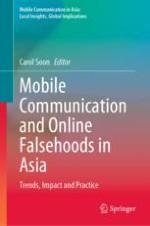2023 | OriginalPaper | Buchkapitel
4. Orders of Discourse and the Ecosystem of Rumour Management on WeChat
verfasst von : Mingyi Hou
Erschienen in: Mobile Communication and Online Falsehoods in Asia
Verlag: Springer Netherlands
Aktivieren Sie unsere intelligente Suche, um passende Fachinhalte oder Patente zu finden.
Wählen Sie Textabschnitte aus um mit Künstlicher Intelligenz passenden Patente zu finden. powered by
Markieren Sie Textabschnitte, um KI-gestützt weitere passende Inhalte zu finden. powered by
